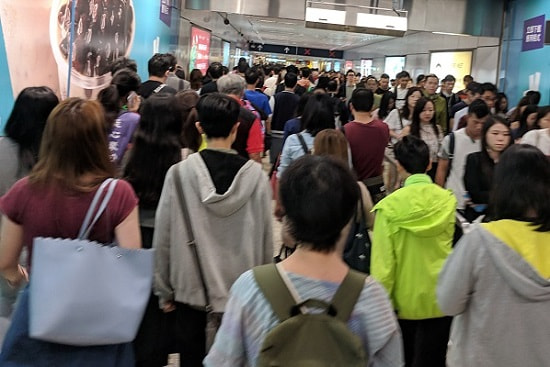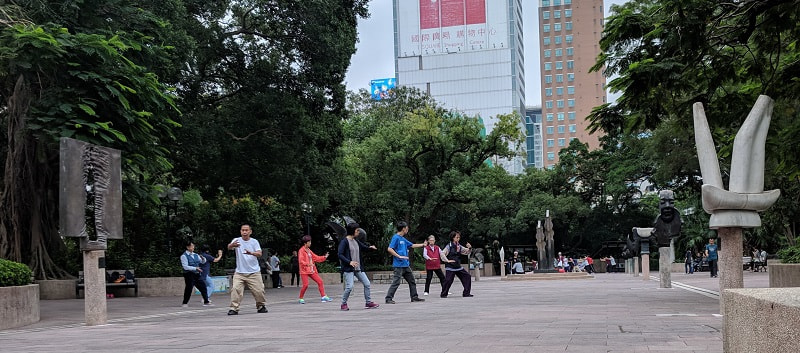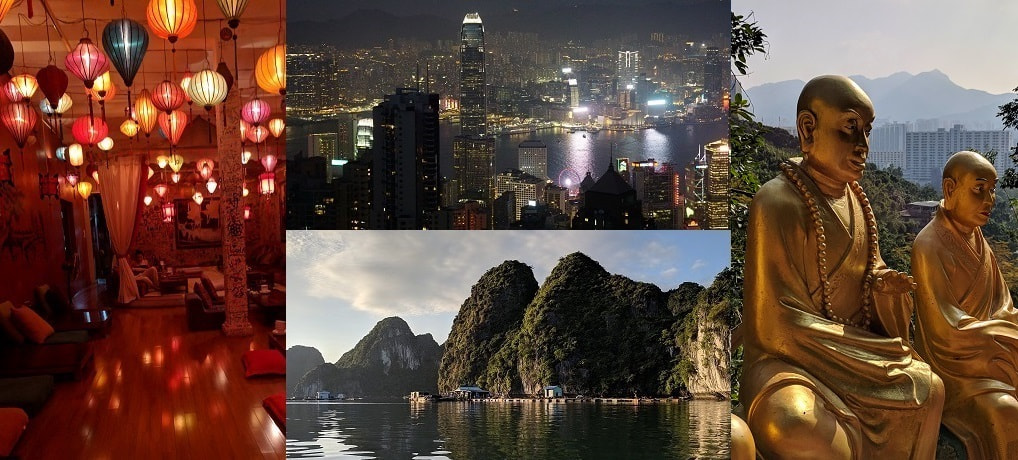
This is some general information on traveling to Hong Kong. Some of this we knew before we got there and some we learned along the way. I cover:
Water
Scarcity: Water is a big problem in Nepal. Since the earthquake in Kathmandu many natural springs that people used for decades have run dry and for some, getting water on a daily basis is a struggle. This is not something that you will most likely contend with as a tourist, but it is good to be aware of.
Drinking Water in the City: As a tourist, what we did encounter were things like yellow water coming from the bathroom tap in the airport when we arrived. The airport, many hotels, and restaurants had water coolers with safe water that you could refill your bottle from. We tried to use these when we could since trash (particularly plastics) is such a problem in the country. We carried this 2L collapsible water bottle so we could take advantage of it whenever it was available.
Bottled water is also readily available and reasonably priced in the cities. It is safest to purchase it from official stores and check the seals for tampering.
Drinking Water While Trekking: Every region has its own laws, but in general bottle water is discouraged, if not banned. Most tea houses offer water for sale and most towns have free taps where you can refill for free and treat or filter it yourself. We used AquaTabs to treat tap water along the trail and didn’t have any problems. You can read more about water on our trek in my article on Annapurna Base Camp - Food & Drink.
Staying Connected
Wifi - In the cities, many hotels and restaurants offer free wifi. While trekking most places offer wifi for about Rs.100. This wifi was better than I expected for how remote it was, but was not always working.
Phones - We use Google’s Project Fi (click for a promo code) for phone service, which allows us service as soon as we get off the plane in most countries, with a data rate of 10 USD per GB. It worked pretty well here, even in the mountains. There are a number of other prepaid sim cards you can buy and most start at 15-20 USD.
GPS & Maps
Even if you don’t have phone service you should always be able to access GPS. I download the maps ahead of time using **Google Maps offline and/or Here Maps (see instructions for how in my Tips/Planning - GPS & Maps Post). Both will allow you to navigate with no service as long as you have the maps downloaded. You can search for an address or GPS points, but general search queries like restaurants generally won’t work.
I like to make a list of the GPS coordinates for each hotel I am staying at and other places of interest ahead of time so I can just enter the coordinates. https://www.gps-coordinates.net/ is a good site to use for this.
Another app that I have not used, but supposedly works well in Nepal is Maps.me
Money
Cash is your only option in Nepal. Many tourist places will accept Nepalese Rupee or USD, but you will usually get a better rate/price with the local currency.
Getting Cash - Everything we saw said not to exchange money at the airport. Well, when we were there the rate at the window in the visa area was actually the best exchange rate we saw. For getting cash we exchanged some at counters and got some from the ATM. All of the ATMs claimed they had a Rs.500 fee but we actually only got charged 1.79 USD the two times we took out money.
The exchange rate fluctuates, but when we were there was about Rs.110 to 1 US dollar. If you have a hard time doing the math in your head I recommend getting an app and/or making up a little card to keep in your pocket or wallet with an exchange chart to help. I laminated mine with a couple pieces of packing tape. I like to have $1-10, then I go up in $5 increments.
What do things cost - Prices in Nepal varied drastically, from roughly the same food prices as the US in the mountains, to expensive in parts of Thamel, to roughly a quarter of what we would pay in the US in other areas. See Nepali Food and ABC Trekking - Food & Drink for a better idea.
Transportation
There are many options for transit, including trains, taxis, buses, ferries, ding ding, and Uber (works as long as you have data), and we used most of them. I like to use Google Maps and Rome2Rio for an idea of what options are available for getting around and what the approximate cost will be. See the section below for Airport specific transportation.
Bus - There are small local buses and big city buses. Both run fairly regular schedules and most are air conditioned. Most buses change a flat rate regardless of how far you go and they always require the exact fare if you pay cash. You can pay extra, but there is no change. For the local buses you usually raise a hand to stop it, but everyone is required to have a seat, so if you see a bus pass you it may be full. For the city buses most stops have large signs at the stops for people to line up at. Some even have marked queuing areas for each separate bus line. We really enjoyed riding in the front on the upper level of the double decker buses. You get to see so much!
Airport
The airport is clean and modern. They have trains to move people between terminals and it is pretty easy to find your way around. There are several food options and while they weren’t cheap, they were not bad by airport standards. There are also several places to fill water bottles. Customs was quick and efficient.
Transportation Options:
Taxi/Uber - You can do it and it may make sense depending on where you are headed or if you come in late with a group, but it is generally a waste of money and only saves a little time.
Temperature/Weather
Hong Kong is warm and semi-tropical year round so pack appropriately. Check Holiday Weather or a similar website for the typical weather at the time of year you are visiting. You never know when there will be a sudden shower. I usually carry a couple ziploc bags since they are very small and light, just in case I need to protect my phone or other electronics.
Keeping Dry and Comfortable:
-
Footwear: Hong Kong is a big city with surprising amount of ups and down, but it is all paved. Your standard walking shoes will probably fine if you are traveling in the dry season and don’t plan on hiking. We only had room for one pair of shoes and planned on doing Suicide Cliff so we used hiking shoes for our everyday footwear. I had Salomon X Ultra Prime Cs Waterproof Hiking Shoes and my husband had Mizuno Wave Rider 21 GTX Running Shoes. We both really liked our shoes. My hiking shoes may have been a little bit overkill for walking around the city, but we didn’t have room for extra shoes and they were great for hiking. I tested my shoes out in the water and I could step in and fully submerge the laces without a drop of water getting inside.
-
Rain Gear: Other than some ziploc bags, we both had a regular rain jacket. We had nothing but sunshine so we never had to use them. Depending on the season a packable one (like these woman’s/men’s) would be a good option.
Culture & Language
Language - Chinese and English are the official languages. Street signs and the metro will be in both, but Chinese is definitely more widely spoken and used. Many shops will only have Chinese signs and in many restaurants you will need to request an English menu. We encountered many people who did not speak English but got along just fine with gestures. According to our walking tour guide, schools are only required to teach a couple classes of basic English.
Culture - Hong Kong has an interesting history as an English Territory that only rejoined China (mostly) in 1997. Wendover - How Hong Kong Changed Countries does a great job of explaining the transition of power. I say mostly because Hong Kong is a special economic zone with it’s own government, laws, economy, and currency, separate from China. It is an interesting mix of proud Chinese culture and a legacy of places named for British Royalty (ie. Victoria Peak).
We were only in Hong Kong for a couple days, so this is just from my brief impression of the city and it’s people. I read that people were loud and rude as a part of the culture. We did not find that to be the case. On the contrary, we were amazed at how polite people were and how respectful of personal space.

If you ever visit New York City you should expect to be bumped and jostled at crosswalks and especially on public transit and in other countries we have been packed into buses to the extent where we were in full bodily contact with people on all sides. In Hong Kong we were amazed how well everyone navigated the public transit systems, moving quickly in one steady stream without touching. People stood in polite lines at the bus stops and while the trains could be crowded, everyone had their personal bubble and a word or touch on the shoulder was used to exit the train instead of elbowing through.

We were also impressed by the apparent culture of exercise. We saw people of all ages doing Tai Chi, Yoga, and other forms of exercise all over the city.
Religion - I was a bit perplexed when I was looking up temples and saw mention of icons from multiple religions being housed in the same temple. At first I thought this may be due to real estate being so expensive, but after some more research I came to understand that many religions are not religions in a strict sense, but more philosophies on how to live a good life. In that way you can pick the best principles of each and use them together to shape your life. Hong Kong Traveler talks a bit more about this concept and the most popular deities. We visited the Ten Thousand Buddha Monastery and the Man Mo Temple and would highly recommend both of them.
Bathrooms
Bring your own toilet paper, it is commonly not provided
Although they are not very popular in Hong Kong, at some point you may be confronted with the style of toilet that we affectionately refer to as a “squatty potty.” This is a toilet with water that is below the ground level and has grippy spots for your feet on either side. You put your feet on the foot spots and simply squat to do your business, which really isn’t too bad, but takes a little getting used to. In Malaysia I saw muddy foot prints on a European style toilet seat, where someone was apparently doing some risky acrobatics to use it in this way.

Many public toilets can now be found by searching on Google Maps. Most major MTR stations (behind the gates) and shopping malls have public bathrooms. Make sure to get to a bathroom with time to spare, as they can often have long lines. Waiting for over 5 minutes is not unusual, at least for the ladies’ room. The wait at Victoria Peak was closer to 15 minutes.
Visas & Immigrations
Visa - Most visitors don’t need them. Hong Kong is a special zone that is part of China, but is governed by different rules. While you need a visa to visit China, for most countries you only need a valid passport for short stays in Hong Kong, but make sure you check what the restrictions are. China Highlights has a detailed list with how long you may stay without a visa by country. Also be careful if you plan to visit Hong Kong as part of your trip to China, because single entry visas for China generally count going to Hong Kong as leaving the country.
Immigrations - A small questionnaire was passed out on the flight and collected at immigrations. It asked pretty standard stuff like your home address, where, and for how long you will be staying. The immigrations process was pretty painless and they didn’t even ask any questions. Unfortunately, they don’t stamp passports, so if you covet those stamps you are out of luck.
Good luck everyone and feel free to leave any questions (or share your own tips) in the comments below.
Product Links: I am not sponsored by any of the products I link to. If you choose to make a purchase from one of the links of a product I listed or any other item a small percentage will go back to me to fund this website, at no additional cost to you. The products I link to are either ones I have used or similar if those are not available. Thank you for your support.
More?
Check out our full Hong Kong & Vietnam Trip Itinerary.

Or our full South East Asia Trip Itinerary.
